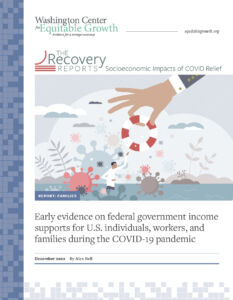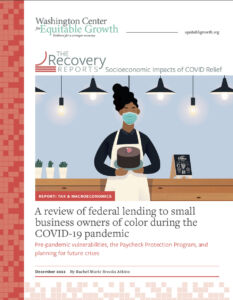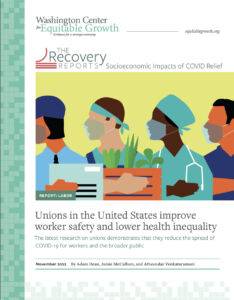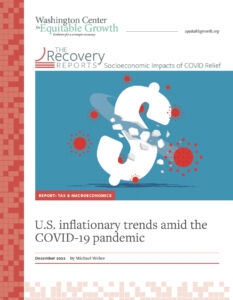The Recovery Reports: Socioeconomic Impacts of COVID-19 Relief
The COVID-19 pandemic and subsequent short but sharp recession exposed deep fragilities in the U.S. economy—one rife with historically high levels of economic inequality, structural racial and gender inequities, and deeply inadequate public investments in our nation’s social infrastructure. Amid the ongoing pandemic, these fragilities continue to exacerbate the economic insecurities caused by decades of declining public investments in infrastructure and people, sapping the growth potential of the U.S. economy.
At the height of the COVID-19 recession, however, the federal government made a number of sizeable investments in our nation’s social infrastructure—investments that swiftly reversed the deep economic downturn in 2020 and contributed significantly to the speedy economic recovery. These investments demonstrated that policymaking tools exist to support strong, stable, and broadly shared growth while addressing underlying structural issues, including racial and gender inequities, climate change, and the need for 21st century social infrastructure.
The four reports that comprise “The Recovery Reports: Socioeconomic Impacts of COVID-19 Relief” examine key aspects of a number of important public policy decisions and investments in 2020 and 2021. These reports explore whether and how these actions helped relieve the pain of the recession and jumpstart the economic recovery while addressing the needs of those U.S. workers and families with the least available financial means to rebound from the recession on their own and then contribute to a more equitable economic recovery.

Early evidence on federal government income supports for U.S. individuals, workers, and families during the COVID-19 pandemic

This report focuses on preliminary research surrounding the three largest income support programs that were paid directly to U.S. individuals, workers, and families: economic impact payments, Unemployment Insurance, and the expanded Child Tax Credit. U.S. policymakers implemented these three programs to stimulate the U.S. economy by bolstering consumption and alleviate the hardship of those most severely affected by the onset of the pandemic and the resulting recession in 2020. This report examines each of these three programs to see what worked and explore the implementation challenges and suggests some policymaking takeaways and avenues for further research.
Authored by Alex Bell, University of California, Los Angeles
A review of federal lending to small business owners of color during the COVID-19 pandemic

This report examines how more than $800 billion in funding under the Paycheck Protection Program—enacted by the U.S. Congress in 2020 amid the COVID-19 recession—was delivered through financial institutions that continually underserve business owners of color to understand whether the funding was distributed less equitably than the U.S. Congress intended. The report’s preliminary policy recommendations are that federal policymakers should prepare for the next crisis now by correcting the institutional biases in the U.S. financial system that continue to lead to racial and ethnic disparities in lending to small business owners of color and consider providing relief directly to these business owners rather than having private financial institutions act as intermediaries, as they did in the Paycheck Protection Program.
Authored by Rachel Marie Brooks Atkins, St. John’s University
Unions in the United States improve worker safety and lower health inequality

This report shows that labor unions in one key sector of the care economy—nursing homes—can mitigate market failures that lead to pervasive workplace safety problems by providing workers with a voice in the workplace and enabling them to bargain collectively with their employers. Safe worksites are often won through union-led struggles, not automatically generated by market competition. The benefits of unionization may be especially large for Black workers, who are often exposed to the most dangerous workplace hazards, in nursing homes and writ large in U.S. workplaces. Our findings suggest that unionization improves health outcomes for workers and reduces racial health inequalities—dynamics that are consistent with broader research that links public health and racial equality to stronger economic growth.
Authored by Adam Dean, George Washington University; Jamie McCallum, Middlebury College; and Atheendar Venkataramani, University of Pennsylvania
U.S. inflationary trends amid the COVID-19 pandemic

This report examines why inflationary expectations amid the continuing COVID-19 pandemic could be hard to suppress. There are a number of heterogeneous factors at play around the world and in the United States affecting inflationary pressures, but once future inflationary expectations take hold in an economy, reversing them is hard to do. U.S. households react very differently to inflationary expectations by income. And U.S. businesses react differently to wage pressures and to industry-specific inflationary pressures for the inputs they need to make the products they sell and the profit margins they seek to maintain. The main findings are that the inflationary expectations of U.S. households are, by and large, set by their consumption patterns based on their incomes—a key determinant that the Federal Reserve Board’s anti-inflationary toolkit is not specifically designed to tackle, and that the Fed’s blunt interest rate hikes cannot account for the heterogeneous factors that go into the inflationary expectations of U.S. workers and businesses across many industries.
Authored by Michael Weber, University of Chicago

